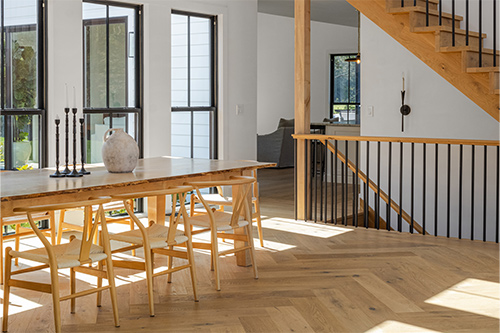Relative Humidity + Why it’s Important

Maximum Stability
The construction of Sawyer Mason plank floors offers maximum stability especially in floors with wide widths and long lengths that are more prone to movement. The structure of our floors takes more time to build, but the results are worth the extra effort. Individual filets are placed cross-grain (or, perpendicular to the length of the board) to provide the most strength and stability while still allowing the wood to breathe with changes in environment.
However, all hardwood floors, and all wood in general, are susceptible to swelling and shrinking from the absorption and loss of moisture in the air, or relative humidity.
.
.
What is Relative Humidity?
Relative humidity is the ratio of the amount of water vapor actually present in the air to the greatest amount possible at the same temperature. When the air in your home reaches a specific amount of water vapor, it will condense as moisture, causing the air to feel damp, which, over time, can negatively impact your floors.
Relative humidity should be between 35-55%, ideally 45% for your Sawyer Mason floors. Temperatures in the home should be between 60-80 degrees Fahrenheit. This relative humidity parameter includes during acclimation, installation, and after.
Every builder, installer and contractor should use a hygrometer, or humidity gauge, to measure the relative humidity in the home before the flooring is brought into the home. Heating or air conditioning units should be operating at least five days before delivery of the floors, during installation, and after the floors are installed. Homeowners should also have a humidity gauge to make sure that it is not too dry or too humid for their flooring. Humidity gauges can be purchased online or at a local big box store such as The Home Depot for under $20.
If humidity is lower than 35%, it is too dry. We recommend using humidifiers in the home. House plants will also help emit moisture into the air as well.
If the humidity is higher than 55%, it is too humid and the homeowner should use dehumidifiers to reduce the humidity.
All wood – solid, engineered, structured, strip, wide plank, will move after installation. Wood is a hygroscopic material and will expand and contract naturally. To prevent unnatural moving, we need to make sure the wood is in its comfort zone of relative humidity. If wood splits or cracks, this is most likely because the room is too dry, and the relative humidity is below the comfort zone. If the wood buckles or starts to cup or bow, this is most likely because there is too much moisture in the room and the relative humidity is above the comfort zone.
This ideal humidity range is beneficial for all wood products, including wood cabinets and furniture, as well as for your health of everyone in your home.
For more information about caring for your floors, visit our Care & Maintenance guide.
